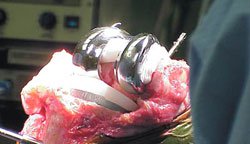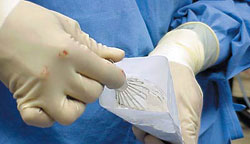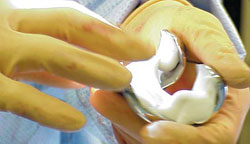Downside of putting antibiotics in cement may be resistant bacteria
With low-dose drugs, allergy, toxicity and reduced structural integrity of the bone cement present less of a concern.
 Fighting infection during joint replacement surgery is a major concern of orthopedic surgeons. One controversial infection prevention method � fixing implants with antibiotic impregnated cement � fights bacteria well but carries many drawbacks, including the potential for allergic reaction, toxicity and resistance.
Fighting infection during joint replacement surgery is a major concern of orthopedic surgeons. One controversial infection prevention method � fixing implants with antibiotic impregnated cement � fights bacteria well but carries many drawbacks, including the potential for allergic reaction, toxicity and resistance.
A debate centered on the controversy at the 21st Annual Current Concepts in Joint Replacement Winter 2004 in Orlando, Fla., with one presenter calling routine mixing of certain antibiotics into bone cement �a model to create resistance.�
At the meeting Kenneth A. Krackow, MD, presented the advantages for using bone cement containing antibiotics, a few varieties of which are now approved by the Food and Drug Administration. Arlen D. Hanssen, MD, at the Mayo Clinic in Rochester, Minn., spoke against its use.
�When we look at clinical fixation as well as clinical results, carefully looking at radiographs, several references in the literature support the conclusion of no problem,� said Krackow, who is at Buffalo General Hospital, Buffalo, N.Y. He cited continual success using .5 g of vancomycin powder mixed into bone cement.
�Antibiotics in cement on a routine basis make a difference. There are many studies today, Norwegian, Swedish and throughout the world, showing statistically significant and therefore clinically significant diminution in infection after surgery, primary surgery, revision surgery, whatever,� Krackow said.
Hanssen noted concerns about pharmacologic toxicity and patients developing allergies from the antibiotics. But, �My bigger concern is actually that of resistance. � Most of us are concerned about these bugs, but in Europe this is a huge problem now � gentamicin-resistant staphylococcus, coag[ulase] negative bugs � and this has been present throughout the literature for some time.�
It is important to prevent these resistance problems from developing or increasing in the United States, Hanssen said. �There are multiple studies now that say that vigilance is needed to reduce the development of multiresistant strains related to the use of antibiotic cement. They�re considering now different types of antibiotics because of this emerging problem. I�m very concerned about this and I think we need to learn from the European example.�
He recommended only using antibiotic impregnated bone cement in high-risk cases for prior septic arthritis, diabetes, rheumatoid arthritis and in patients taking immunosuppression medication or who have malignancies. �Other than that I do not think that it should be used on a routine basis.�
|
|
 | This photograph taken near the conclusion of a procedure Krackow recently performed shows all of the components cemented into place. In addition to tobramycin, Krackow said he has had good success using 0.5 g of vancomycin powder mixed into bone cement. COURTESY OF KENNETH A. KRACKOW |
Gives patients a fighting chance
Krackow agreed that using this kind of cement in high-risk cases is warranted, but its use should also be avoided in cases where patients are allergic to the antibiotic.
|
But one of the main reasons for using antibiotic cement is to help fight the organisms that exist in the OR and invariably get implanted along with a prosthesis during total joint replacement (TJR), he said. �You�re going to knock off some of the organisms probably that are in there. You�ll have a smaller number of total organisms for the body to fight and you have maybe even some chance for the inherent immune and cellular mechanisms to clear that infection.�
Hanssen said the rate of deep periprosthetic infection in TJR is already extremely low and antibiotics may not help that situation much. Furthermore, guidelines have been established to prevent the practice of routinely mixing vancomycin into the bone cement during TJR. �Every hospital in the country has been directed to ask their people not to use vancomycin for prophylaxis because of federal guidelines.�
In his abstract Hanssen said surgeons should avoid even using some alternative drugs in the face of gentamicin-resistant bacteria, like cefuroxime or ciprofloxacin, because it has been associated with an increased risk of allergic reaction. Should a patient develop an allergy to the antibiotic, all of the implants would have to be explanted. �This hasn�t happened, but if we start changing the antibiotic profiles, this is a concern that we�re going to need to face.�
For more information:
- Krackow KA. Primary use of antibiotic cement: A prophylaxis of choice � affirms. #5.
- Hanssen AD. Primary use of antibiotic cement: A prophylaxis of choice � opposes. #6. Both presented at the 21st Annual Current Concepts in Joint Replacement Winter 2004 Meeting. Dec. 8-11, 2004. Orlando, Fla.


